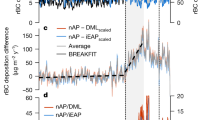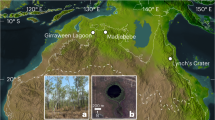Abstract
MANY hypotheses have been advanced to explain the mass extinction at the Cretaceous/Tertiary (K/T) boundary1–3. Recently, Wolbach et al. 4 suggested that massive forest fires were triggered by the impact of a meteorite, and cite as evidence the presence of elemental carbon (mainly soot) from K/T boundaries5. Almost all of the airborne polycyclic aromatic hydrocarbons (PAHs) generated by pyrosynthesis are adsorbed, through hydrogen bonding, on the surface of soot, the participate fraction from combustion6,7. Although soot itself is a polymer of polybenzenoid radicals, early termination of polymerization leads to enhanced PAH production. Pyrosynthesis of PAHs is thus favoured by a chemically reducing atmosphere. If there were wildfires, a group of high-molecular-weight parent PAHs characteristic of combustion, predominating over their alkyl homologues8,11, should be present in K/T boundary samples known to contain soot4,5. Here we compare K/T samples from New Zealand, Italy and Denmark to those from above and below the boundary, and find enhanced PAH contents and distribution profiles that reflect a pyrolytic origin. The data thus provide the first detailed organic-molecular evidence for the combustion source of organic carbon at the K/T sites.
This is a preview of subscription content, access via your institution
Access options
Subscribe to this journal
Receive 51 print issues and online access
$199.00 per year
only $3.90 per issue
Buy this article
- Purchase on Springer Link
- Instant access to full article PDF
Prices may be subject to local taxes which are calculated during checkout
Similar content being viewed by others
References
Alvarez, W., Alvarez, L. W., Asaro, F. & Michel, H. V. Science 223, 1183–1186 (1984).
Officer, C. B. & Drake, C. L. Science 227, 1161–1167 (1985).
Hallam, A. Science 238, 1237–1242 (1987).
Wolbach, W. S., Lewis, R. S. & Anders, E. Science 230, 167–170 (1985).
Wolbach, W. S., Gilmour, I., Anders, E., Orth, C. J. & Brooks, R. R. Nature 334, 665–669 (1988).
Neff, J. M. Polycyclic Aromatic Hydrocarbons in the Aquatic Environment: Sources Fates and Biological Effects (Applied Science, London, 1979).
Commins, B. T. Atmos. Envir. 3, 565–572 (1969).
Youngblood, W. W. & Blumer, M. Geochim. cosmochim. Acta 39, 1303–1314 (1975).
Hites, R. A., Laflamme, R. E. & Windsor, J. G., Jr, in Advances in Chemistry Series 185 (eds Petrakis, L. & Weiss, F. T.) 289–311 (Am. chem. Soc., Washington, DC, 1980).
Venkatesan, M. I., Ruth, E. & Kaplan, I. R. Am. chem. Soc. 192nd Mtg, Anaheim, California, September 1986.
Sporstøl, S. et al. Envir. Sci. Technol. 17, 282–286 (1983).
Schmitz, B. Geology (in the press).
Strong, C. P. N.Z. J. Geol. Gephys. 20, 687–696 (1977).
Brooks, R. R. et al. Science 226, 539–542 (1984).
Crocket, J. H., Officer, C. B., Wezel, F. C. & Johnson, G. D. Geology 16, 77–80 (1988).
Venkatesan, M. I., Ruth, E., Steinberg, S. & Kaplan, I. R. Mar. Chem. 21, 267–299 (1987).
Schmitz, B., Andersson, P. & Dahl, J. Geochim. cosmochim. Acta 52, 229–236 (1988).
Blumer, M. Chem. Geol. 16, 245–256 (1975).
Kamens, R. M., Guo, Z., Fulcher, J. N. & Douglas, A. B. Envir. Sci. Technol. 22, 103–108 (1988).
Ramdahl, T. Nature 306, 580–582 (1983).
Simoneit, B. R. T. & Lonsdale, P. F. Nature 295, 198–202 (1982).
Laflamme, R. E. & Hites, R. A. Geochim. cosmochim. Acta 42, 289–303 (1978).
Gilmour, I. & Guenther, F. Conf. on Global Catastrophes in Earth History Snowbird, Utah, 60–61 (1988).
Volkman, J. K., Alexander, R., Kagi, R. I., Rowland, S. J. & Sheppard, P. N. Org. Geochem. 6, 619–632 (1984).
Clayton, J. L. & King, J. D. Geochim. cosmochim. Acta 51, 2153–2157 (1987).
Simoneit, B. R. T. & Beller, H. R. Init. Rep. DSDP 93, Ch. 52 (eds van Hinte, J. E. et al.) 1211–1215 (US Govt Printing Office, Washington, DC, 1987).
Pereira, W. E., Rostad, C. E., Taylor, H. E. & Klein, J. M. Envir. Sci. Technol. 16, 387–396 (1982).
Simoneit, B. R. T. Geochim. cosmochim. Acta 41, 463–476 (1977).
Venkatesan, M. I. Org. Geochem. 12, 13–27 (1988).
Author information
Authors and Affiliations
Rights and permissions
About this article
Cite this article
Venkatesan, M., Dahl, J. Organic geochemical evidence for global fires at the Cretaceous/Tertiary boundary. Nature 338, 57–60 (1989). https://doi.org/10.1038/338057a0
Received:
Accepted:
Issue Date:
DOI: https://doi.org/10.1038/338057a0
This article is cited by
-
Evidence of biotic recovery through the Cretaceous/Palaeogene transition from the Mahadeo-Cherrapunji succession in the Meghalaya shelf, India
Palaeobiodiversity and Palaeoenvironments (2023)
-
Coal measure metallogeny: Metallogenic system and implication for resource and environment
Science China Earth Sciences (2022)
-
Palaeobotanical and biomarker evidence for Early Permian (Artinskian) wildfire in the Rajmahal Basin, India
Journal of Palaeogeography (2021)
-
Polycyclic Aromatic Hydrocarbons in Permian Coals of India: Source and Significance
Journal of the Geological Society of India (2019)
-
How does fire affect the nature and stability of soil organic nitrogen and carbon? A review
Biogeochemistry (2007)
Comments
By submitting a comment you agree to abide by our Terms and Community Guidelines. If you find something abusive or that does not comply with our terms or guidelines please flag it as inappropriate.



